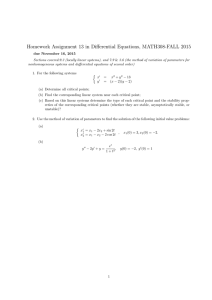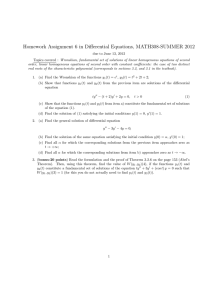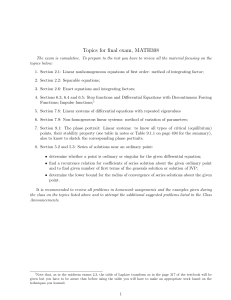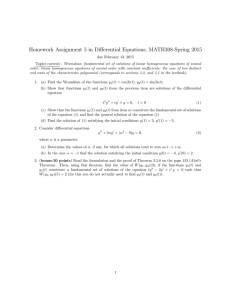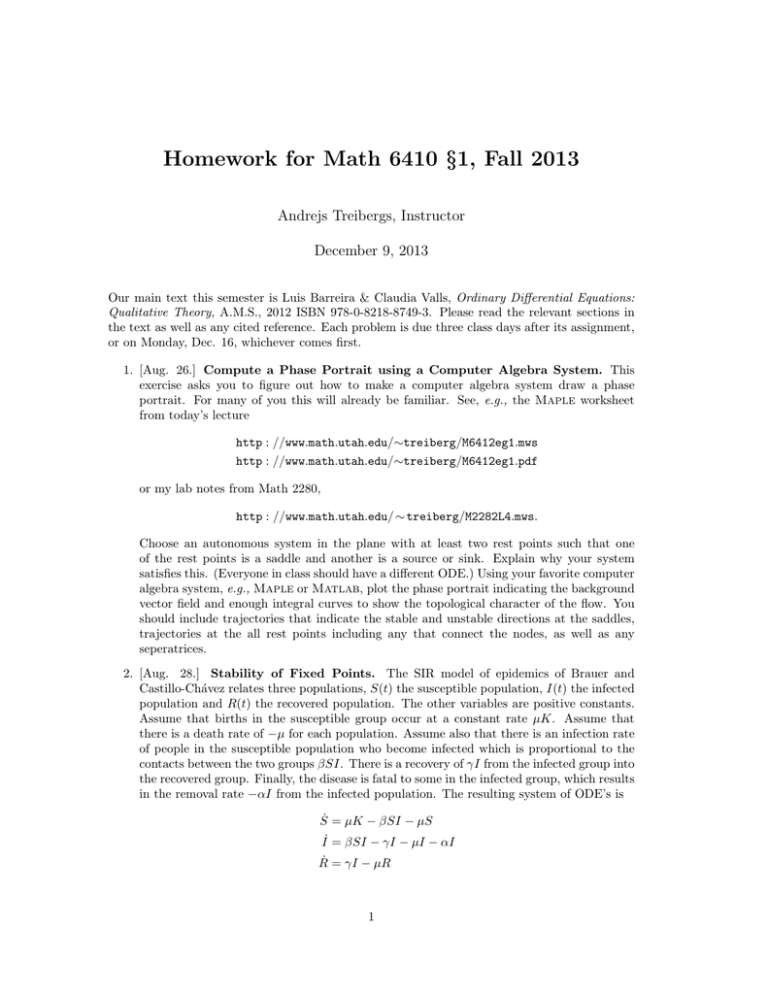
Homework for Math 6410 §1, Fall 2013
Andrejs Treibergs, Instructor
December 9, 2013
Our main text this semester is Luis Barreira & Claudia Valls, Ordinary Differential Equations:
Qualitative Theory, A.M.S., 2012 ISBN 978-0-8218-8749-3. Please read the relevant sections in
the text as well as any cited reference. Each problem is due three class days after its assignment,
or on Monday, Dec. 16, whichever comes first.
1. [Aug. 26.] Compute a Phase Portrait using a Computer Algebra System. This
exercise asks you to figure out how to make a computer algebra system draw a phase
portrait. For many of you this will already be familiar. See, e.g., the Maple worksheet
from today’s lecture
http : //www.math.utah.edu/∼treiberg/M6412eg1.mws
http : //www.math.utah.edu/∼treiberg/M6412eg1.pdf
or my lab notes from Math 2280,
http : //www.math.utah.edu/ ∼ treiberg/M2282L4.mws.
Choose an autonomous system in the plane with at least two rest points such that one
of the rest points is a saddle and another is a source or sink. Explain why your system
satisfies this. (Everyone in class should have a different ODE.) Using your favorite computer
algebra system, e.g., Maple or Matlab, plot the phase portrait indicating the background
vector field and enough integral curves to show the topological character of the flow. You
should include trajectories that indicate the stable and unstable directions at the saddles,
trajectories at the all rest points including any that connect the nodes, as well as any
seperatrices.
2. [Aug. 28.] Stability of Fixed Points. The SIR model of epidemics of Brauer and
Castillo-Chávez relates three populations, S(t) the susceptible population, I(t) the infected
population and R(t) the recovered population. The other variables are positive constants.
Assume that births in the susceptible group occur at a constant rate µK. Assume that
there is a death rate of −µ for each population. Assume also that there is an infection rate
of people in the susceptible population who become infected which is proportional to the
contacts between the two groups βSI. There is a recovery of γI from the infected group into
the recovered group. Finally, the disease is fatal to some in the infected group, which results
in the removal rate −αI from the infected population. The resulting system of ODE’s is
Ṡ = µK − βSI − µS
I˙ = βSI − γI − µI − αI
Ṙ = γI − µR
1
(a) Note that the first two equations decouple and can be treated as a 2 × 2 system. Then
the third equation can be solved knowing I(t). Let δ = α + γ + µ. For the 2 × 2 system,
find the nullclines and the fixed points.
(b) Check the stability of the nonnegative fixed points. Show that for βK < δ the disease
dies out. Sketch the nullclines and some trajectories in the phase plane in this case.
(c) Show that for βK > δ the epidemic reaches a steady state. Sketch the nullclines and
some trajectories in the phase plane now.
[From R. C. Robinson, An Introduction to Dynamical Systems, Pearson 2004.]
3. [August 30.] Contraction Mapping Principle and a Delay Differential Equation.
(a) Sharpen the Contraction mapping principle: Let E ⊂ Rn , X = C(E, Rn ) be continuous
functions and kuk = supu∈E |u(x)| be the sup-norm. Let 0 < b < ∞ and 0 < k < 1 be
constants and let T : X → X be a transformation. Suppose that for any φ, ψ ∈ X if
kψk ≤ b then kT (ψ)k ≤ b and if kφk ≤ b and kψk ≤ b then
kT (ψ) − T (φ)k ≤ kkψ − φk,
i.e., T is a contraction. Prove that there exists an element ζ with kζk ≤ b such that
ζ = T ζ, that is, T has a fixed point. Prove tha t ζ is the unique fixed point among
points that statisfy kζk ≤ b. [cf. Perko 77[5]]
(b) The delay differential equation involves past values of the unknown function x, and so
its initial data ϕ must be given for all times t ≤ 0. Using the Contraction Mapping
Principle (a.), show the local existence of a solution to the delay differential equation.
Theorem. Let b > 0. Let f ∈ C(R3 ) be a function that satisfies a Lipschitz condition:
there is L < ∞ such that for all t, x1 , x2 , y1 , y2 ∈ R,
|f (t, x1 , y1 ) − f (t, x2 , y2 )| ≤ L(|x1 − x2 | + |y1 − y2 |).
Let g ∈ C(R) such that g(t) ≤ t for all t. Let ϕ ∈ C (−∞, 0], R such that |ϕ(t)−ϕ(0)| ≤
b for all t ≤ 0. Show that there is an r > 0 such that the initial value problem
dx (t) = f t, x(t), x(g(t))
dt
x(t) = ϕ(t)
for all t ≤ 0.
has a unique solution x(t) ∈ C (−∞, r], R ∩ C 1 (0, r), R .
[cf. Saaty, Modern Nonlinear Equations, Dover 1981, §5.5.]
4. [Sept. 4.] Escape Times. Show that each solution x(t), y(t) of the initial value problem
( 0
(
x = y + x2
x(0) = x0
y0 = x + y2
y(0) =
y0
with x0 > 0 and y0 > 0 cannot exist on an interval of the form [0, ∞).
[cf. Wilson, Ordinary Differential Equations, Addison-Wesley, 1971, p.255.]
5. [Sept. 6.] Generalize Gronwall’s Inequality Let u, v, w : [a, b] → R be continuous
functions with w > 0 such that
Z t
u(t) ≤ v(t) +
w(s)u(s) ds
a
2
for every t ∈ [a, b]. Show that
Z
u(t) ≤ v(t) +
t
Z
t
w(σ) dσ
w(s)v(s) exp
ds
s
a
for every t ∈ [a, v]. If in addition, v is non-decreasing, then
Z t
w(s) ds
u(t) ≤ v(t) exp
a
for every t ∈ [a, b].
[cf. Barreira & Valls, Ordinary Differential Equations, A.M.S., 2012 p.54.]
6. [Sept. 9.] Compare Solutions of Two Mathieu Equations. One solution for Problem 19 of the 2010 Math 6410 depended on comparing the solutions of the perturbed and
unperturbed problems. Find a sharp estimate for the difference in values and derivatives
at T = 2π
3 of the solutions for the two initial value problems, where u0 , u1 , are constants.
ẍ + x = 0,
ÿ + (1 + sin(3t))y = 0,
x(0) = u0 ,
y(0) = u0 ,
ẋ(0) = u1 ;
ẏ(0) = u1 .
Let y(t; u0 , u1 , ) solve the IVP. Use your estimate to show |y(T ; 1, 0, ) + ẏ(T ; 0, 1, )| < 2
for small ||.
7. [Sept. 11.] Nagumo’s Uniqueness Theorem. Prove the theorem and show that it
implies the uniqueness statement in the Picard Theorem.
Theorem. [Nagumo, 1926] Suppose f ∈ C(R2 ). Then the initial value problem
dy
= f (t, y),
dt
y(0) = 0,
has a solution by Peano’s Existence Theorem. Assume in addition that
|f (t, y) − f (t, z)| ≤
|y − z|
|t|
for all t, y, z ∈ R such that t 6= 0. Then the solution is unique.
8. [Sept. 13.] Comparison Principle. Suppose that J = (a, b) is an interval, t0 ∈ J
and f (t, x) ∈ C(R2 ) is a function which is locally Lipschitz with respect to x in R2 . Let
x ∈ C 1 (J) be a solution of
dx
(t) = f t, x(t) .
dt
Suppose y : J → R is a differentiable function such that
dy
(t) ≥ f t, y(t) ,
dt
y(t0 ) ≥ x(t0 ).
Prove that y(t) ≥ x(t) for all t0 ≤ t < b.
3
for all t ∈ J,
9. [Sept. 16.] Eternal Solutions. Let f ∈ C 1 (Rn , Rn ) and let h•, •i be an inner product of
Rn . Consider the initial value problem
dx
= f (x)
dt
x(t0 ) = x0
(1)
(a) Show that if hf (x), xi ≤ 0 for every x ∈ Rn then each solution of (1) is defined for all
t ≥ t0 .
(b) Suppose that g ∈ C 1 (Rn ) such that
g(x) ≥ hx, xi
and
hf (x), ∇g(x)i < 0
for all x ∈ Rn \{0}, then each solution of (1) is defined for all t ≥ t0 .
[cf. Barreira & Valls, Ordinary Differential Equations, A.M.S., 2012 p.54.]
10. [Sept. 18.] Concrete Variational Equation. Let
x1 −x1
2 .
f
=
x2 −x2 + x1
2
x3
x3 + x1
Find the solution ϕ(t, y) ∈ R3 of
dx
= f x(t) ,
dt
x(0) = y.
Find
Φ(t, y) = D2 ϕ(t, y).
Show that it satisfies the variational equation
dΦ
= Df ϕ(t, y) · Φ(t, y),
dt
Φ(0) = I.
[Perko, p. 84.]
11. [Sept. 20.] Find a Periodic Solution. This exercise gives conditions for an ordinary
differential equation to admit periodic solutions.
(a) Let J = [0, 1] denote an interval and let φ ∈ C(J, J) be a continuous transformation.
Show that φ admits at least one fixed point. (A fixed point is y ∈ J so that φ(y) = y.)
(b) Assume that f ∈ C(R × [−1, 1]) such that for some L < ∞ and some 0 < T < ∞ we
have
|f (t, y1 ) − f (t, y2 )| ≤ L|y1 − y2 |,
f (T + t, y1 ) = f (t, y1 ),
f (t, −1)f (t, +1) < 0
for all t ∈ R and all y1 , y2 ∈ [−1, 1]. Using (a), show that the equation y 0 = f (t, y) has
at least one solution periodic of period T .
4
(c) Apply (b) to y 0 = a(t)y + b(t) where a, b are T periodic functions.
12. [Sept. 23.] Existence via Schauder’s Theorem. Give another proof of the Peano
Existence Theorem using the Schauder Fixed Point Theorem.
Theorem. [Peano Existence Theorem] Let D ⊂ R × Rn be a domain and f ∈ C(D, Rn ).
Then for any (t0 , x0 ) ∈ D there is > 0 and a continuously differentiable function x(t) :
[t0 − , t0 + ] → Rn which solves the initial value problem
dx
= f (t, (x(t))),
dt
x(t0 ) = x0 .
for all t ∈ [t0 − , t0 + ];
Theorem. [Schauder Fixed Point Theorem] Let A be a closed, bounded, convex subset of
a Banach space X and T : A → A be a completely continuous function. Then T has a fixed
point in A.
A subset K of a Banach space is compact if any sequence in {φi }i=1,2,... ⊂ K has a subsequence that converges to an element in K. f is compact if for any bounded set B ⊂ X , the
closure of the set f (B) is compact. f is completely continuous if it is both compact and
continuous. [cf. Hale, p. 14.]
13. [Sept. 25] Application of Liouville’s Theorem. Find a solution of the IVP for Bessel’s
Equation of order zero
x00 + 1 x0 + x = 0
t
x(0) = 1,
x0 (0) = 0
by assuming the solution has a power series representation (or use Frobenius Method.) Use
Liouville’s formula for the Wronskian to find a differential equation for a second linearly
independent solution of the differential equation. Show that this solution blows up like
log t as t → 0. [cf. Fritz John, Ordinary Differential Equations, Courant Institute of
Mathematical Sciences, 1965, p. 90.]
14. [Sept. 27.] Real Canonical Form. Let A be a real 2 × 2 matrix whose eigenvalues are
a ± bi where a, b ∈ R such that b 6= 0. Show that there is a real matrix Q so that
a −b
−1
Q AQ =
.
b a
Use this fact to solve the system
x0 = −13x − 10y
y 0 = 20x + 15y
15. [Oct. 4.] Jordan Form. Find the generalized eigenvectors, the Jordan form and the
general solution
6
ẏ =
−2
2
5
6
−2
6
4
−4
y.
8
16. [Oct.2.] Just Multiply by t. Consider the n-th order constant coefficient linear homogeneous scalar equation
x(n) + an−1 x(n−1) + · · · + a1 x0 + a0 x = 0
where ai are complex constants. Convert to a first order differential system x0 = Ax.
Show that the geometric multiplicity of every eigenvalue of A is one. Show that a basis of
solutions is {tk exp(µi t)} where i = 1, . . . , s correspond to the distinct eigenvalues µi and
0 ≤ k < mi where mi is the algebraic multiplicity of µi . [cf., Gerald Teschl, Ordinary
Differential Equations and Dynamical Systems, Amer. Math. Soc., 2012, p.68.]
17. [Oct. 4.] To Use Jordan Form or Not to Use Jordan Form. Sometimes the use of
the Jordan Canonical Form and matrices with multiple eigenvalues can be avoided using
the following considerations.
(a) Let A ∈ Mn×n (C). Show that given > 0 there exists a matrix B with distinct
eigenvalues so that kA − Bk ≤ .
(b) Give three proofs of det(eA ) = etrace(A) .
(c) Let A ∈ Mn×n (C). By a simpler algorithm than finding the Jordan Form, one can
change basis by a P that transforms A to upper triangular
u11
0
−1
P AP = U =
.
..
0
u12
...
u22
...
..
.
..
0
...
.
u1n
u2n
.
..
.
unn
(2)
Show that this fact can be used instead of Jordan Form to characterize all solutions of
ẏ = Ay (as linear combinations of products of certain exponentials, polynomials and
trigonometric functions). [c.f., Bellman, Stability Theory of Differential Equations,
pp. 21–25.] )
(d) Let A ∈ Mn×n (C). Show that givenP
> 0 there exists a nonsingular P such that in
addition to (2) we may arrange that i<j |uij | < .
(e) [Optional.] Find all continuous scalar valued functions f ∈ C(Mn×n (C), C) so that
f (AB) = f (A)f (B)
for all A, B.
You can probably find several different arguments on your own. [ibid.; or Kurosh, Higher
Algebra, p. 334.]
18. [Oct. 7.] Variation of Parameters Formula. Solve the inhomogeneous linear system
(
ẋ = A(t) x + b(t),
x(t0 ) = c;
where
2
−2 cos t −1 − sin 2t
,
A(t) =
2
1 − sin 2t
−2 sin t
6
1
,
b(t) =
−2t
e
c1
c=
.
c2
Hint: a fundamental matrix is given by
−2t
cos t
e
U (t, 0) =
e−2t sin t
− sin t
.
cos t
[cf. Perko, Differential Equations and Dynamical Systems, Springer, 1991, p. 62.]
19. [Oct. 9.] Bounded Solutions of Hill’s Equation. Show that if |ε| is sufficiently small,
then all solutions are bounded
ü + 1 + ε sin(3t) u = 0.
[U. Utah Preliminary Examination in Differential Equations, January 2004.]
20. [Oct. 11.] Periodic Inhomogeneous Equations. Suppose that the A(t) and b(t) are
continuous T > 0 periodic matrix and vector functions such that none of the characteristic
multipliers of
y 0 = A(t)y
equals one. Then there is a unique T -periodic solution (which may be identically zero) to
the inhomogeneous equation
y 0 = A(t)y + b(t).
[cf. Cronin, Ordinary Differential Equations, Introduction to Qualitative Theory, 3rd ed.,
Chapman & Hall/CRC, 2008, p. 84.]
21. [Oct. 21.] Polar Coordinates. Let a, b and p be positive constants. Consider the
differential equation
ẋ = − p
ẏ = − p
ax
x2 + y 2
ay
x2 + y 2
+b
which models the flight of a bird heading toward the origin at constant speed a, that is moved
off course by a steady wind of velocity b. Determine the conditions on a and b to ensure
that the solution starting at (p, 0) reaches the origin. Hint: change to polar coordinates and
study the phase portrait of the differential equation on the cylinder. [Chicone, Ordinary
Differential Equations with Applications, Springer 1999, p. 86.]
22. [Oct. 23.] Condition for Asymptotic Stability. Suppose that the zero solution to
ẋ = Ax is asymptotically stable. Let g(t, x) ∈ C 1 (R × Rn , Rn ) satisfy g(t, 0) = 0 and
for all t ≥ 0 and x ∈ Rn ,
|g(t, x)| ≤ h(t)|x|,
where h(t) satisfies for positive constants k and r,
Z t
h(s) ds ≤ kt + r,
for all t ≥ 0.
0
Show that there is a constant k0 (A) > 0 such that if k ≤ k0 , then the zero solution of
ẋ = Ax + g(t, x)
is asymptotically stable. [cf. James H. Liu, A First Course in the Qualitative Theory of
Differential Equations, Prentice Hall 2003, p. 243.]
7
23. [Oct. 25.] Liapunov Functions. Use a Liapunov Function to show that the zero solution
is asymptotically stable
ẍ + (2 + 3x2 ) ẋ + x = 0.
Hint: Show that this equation is equivalent to the system
ẋ = y − x3
ẏ = −x + 2x3 − 2y.
[D. W. Jordan and P. Smith, Nonlinear Ordinary Differential Equations: An Introduction
for Scientists and Engineers, 4th ed., Oxford U. Press, 2007, pp. 348–349.]
24. [Oct. 28.] Četaev’s Theorem. Show that the zero solution is not stable.
ẋ = x3 + xy
ẏ = −y + y 2 + xy − x3 .
[J. Hale and H. Koçek, Dynamics and Bifurcations, Springer 1991, p. 286.]
25. [Oct. 30.] La Salle’s Invariance Principle. Assume that the continuously differentiable
functions satisfy f (x) > 0 and xg(x) > 0 for x 6= 0. Use La Salle’s Invariance Principle to
show that the zero solution of
ẍ + f (x) ẋ + g(x) = 0
is asymptotically stable. [Brauer & Nohel, The Qualitative Theory of Ordinary Differential
Equations: An Introduction., Dover, 1989.]
26. [Nov. 1.] Asymptotically Stable Equilibrium in a Discrete Dynamical System.
(a) Let A be a real n × n matrix such that |λ| < γ for all eigenvalues λ of A. Show that
there is a norm k · k on Rn so that kAxk ≤ γkxk for all x ∈ Rn .
(b) Let P ∈ C 1 (Rn , Rn ) such that P (0) = 0 and |λ| < 1 for all eigenvalues of DP (0). Show
that 0 is an asymptotically stable fixed point of the discrete dynamical system in Rn
xn+1 = P (xn ),
x1 = ξ.
27. [Nov. 4.] Topological Conjugacy. Let
−α
A=
−β
β
,
−α
−1
B=
0
0
,
−1
α > 0.
Explicitly construct the conjugacy found in the proof of Theorem 2.50. [cf., Gerald Teschl,
Ordinary Differential Equations and Dynamical Systems, Amer. Math. Soc., 2012, p.270.]
28. [Nov. 6.] Hartman-Grobman Theorem. Find a homeomorphism h in a neighborhood of
0 that establishes an topological conjugacy between the flow of the differential system and
the flow of the linearized system, i.e., h(ψ(t, x)) = etA h(x) where A = Df (0) and ψ(t, x0 )
is the solution of ẋ = f (x), the nonlinear system given by
ẋ = −x
ẏ = −y + xz,
ż = z.
[In §4.2, Barreira & Valls discuss a proof, but you can guess h from the solutions and verify.]
8
29. [Nov 8.] International Whaling Commission Model. A simple rescaled difference
equation for modeling the population un of sexually mature baleen whales is
un+1 = sun + R(un−T ),
where 0 < s < 1 is the survival parameter, T is an integer corresponding to time to sexual
maturity, and R(un−T ) is the recruitment function that augments the adult population
from births T years earlier. If
R(u) = (1 − s)[1 + q(1 − u)]u,
where q > 0 describes the fecundity increase due to low density and the delay is T = 1,
derive the condition for a positive steady state u∗ to be stable and find for which q it holds.
[J. D. Murray, Mathematicsl Biology, Biomathematics Texts 19, Springer 1989, p. 62.]
30. [Nov. 11.] Small Perturbation of an Invertible Linear Map.
invertible real n × n matrix. Suppose that α : Rn → Rn satisfies
Syppose A is an
|α(x) − α(y)| ≤ δ|x − y|
for all x, y ∈ Rn . Show that there is ε > 0 so that if δ < ε then the map
h(x) = Ax + α(x) : Rn → Rn
is a homeomorphism.
[Chicone, Ordinary Differential Equations with Applications, Springer 1999, p. 315.]
31. [Nov. 13.] Stable and Unstable Manifolds. Find the stable manifold W s and unstable
manifold W u near the origin of the system
ẋ = −x
ẏ = −y + x2
ż = z + y 2 .
[cf. Perko, Differential Equations and Dynamical Systems, Springer, 1991, p. 116–117.]
32. [Nov. 15.] Traveling Wave. For constant r > 0 let u(x, t) be a real valued function
satisfying Fisher’s Equation
∂u
∂2u
=
+ ru(1 − u),
∂t
∂x2
for x ∈ R and t ≥ 0.
which models the spread of disease. A special solution is the traveling wave, u(t, x) =
v(x − ct) where c > 0 is the wave speed.
(a) Show that the traveling wave satisfies the ODE
v 00 + cv 0 + rv(1 − v) = 0,
where v 0 = dv/ds and s = x − ct.
√
(b) Show that for every c ≥ 2 r, Fischer’s Equation has a traveling wave solution satisfying v(s) → 1 as s → −∞ and v(s) → 0 as s → ∞ with v 0 (s) < 0 for all s. [Hint:
Discuss the stability properties of equilibrium points. Use special properties of the
unstable manifold at (1, 0). Show there is a forward invariant triangle in the (v, v 0 )
plane bounded by the lines v 0 = 0, v = 1 and v 0 = −µv for appropriate µ > 0. ]
9
[cf. J. Hale and H. Koçek, Dynamics and Bifurcations, Springer 1991, p. 299.]
33. [Nov. 18.] Brusselator System. Show that there is a non-constant periodic trajectory
for the system
ẋ = 1 − 4x + x2 y
ẏ = 3x − x2 y
[University of Utah Ph.D. Preliminary Examination in Differential Equations, August 2004.]
34. [Nov. 20.] Periodic Orbits in Three Space. Verify that there exists an autonomous
equation in R3 with a periodic orbit but without fixed points.
[cf. Barreira & Valls, Ordinary Differential Equations, A.M.S., 2012 p. 197.]
35. [Nov. 22.] Dulac’s Criterion. Prove the following theorem.
Theorem. Let A ⊂ R2 be an annular domain. Let f ∈ C 1 (A, R2 ) and let ρ ∈ C 1 (A, R).
Show that if div(ρf ) is not identically zero and does not change signs in any open subset
of A then the equation x0 = f (x) has at most one periodic solution in A.
Use this to show that the van der Pol oscillator (λ = const. 6= 0)
ẋ = y
ẏ = −x + λ(1 − x2 )y
has at most one limit cycle in the plane. Hint: let ρ = (x2 + y 2 − 1)−1/2 . [Chicone, Ordinary
Differential Equations with Applications, Springer 1999, p. 90.]
36. [Nov. 25.] Periodic Orbit in Predator-Prey System. A generalization of a predatorprey system given by Brauer and Castillo-Chavez is
y
x
−
,
ẋ = x 1 −
30 x + 10
x
1
ẏ = y
−
.
x + 10 3
(a) Show that the fixed points are (0, 0), (30, 0) and (5, 12.5) and have saddle, saddle,
source type, resp.
(b) Show that the region bounded by 0 ≤ x, 0 ≤ y and x + y ≤ 50 is forward invariant.
(c) Show that there is no orbit Γ with α(Γ) = {(30, 0)} and ω(Γ) = {(0, 0)}. Conclude
that there is a nonconstant periodic orbit.
[R. C. Robinson, An Introduction to Dynamical Systems Continuous and Discrete, Pearson/Prentice Hall, 2004, p. 238.]
37. [Nov. 9.] Stability of a Periodic Orbit. A periodic solution to the system
1
ẋ = x − 4y − x3 − xy 2
4
1 2
ẏ = x + y − x y − y 3
4
ż = −z,
is γ(t) = (2 cos 2t, sin 2t, 0). Is γ(t) orbitally asymptotically stable? Choose a transverse
planar section L. Determine the Poincaré map ℘ : L → L and find its differential at the
periodic orbit. In particular, find the variational equation, the fundamental matrix associated with the periodic orbit and compute the Floquet Multipliers. [cf. Perko, Differential
Equations and Dynamical Systems, Springer, 1991, p. 213.]
10
38. [Dec. 2.] Stability of a Periodic Orbit. Let f ∈ C 2 (R2 ) be such that zero is a regular
value (∇f (x) 6= 0 whenever f (x) = 0.) Then the zero level set
A = (x, y) ∈ R2 : f (x, y) = 0
consists of embedded C 2 curves. Prove that each bounded component of A is an attracting
hyperbolic limit cycle for the differential equation
ẋ = −fy − f fx ,
ẏ = fx − f fy .
Describe the phase portrait in case
f (x, y) = (x − µ)2 + y 2 − 1 x2 + y 2 − 9 .
[Chicone, Ordinary Differential Equations with Applications, Springer 1999, p. 197.]
39. [Dec. 4.] Perturbation of Stable Solution of van der Pol Equation. Suppose
g ∈ C 2 (R2 ) and µ > 0. Show that there is an ε0 > 0 such that for |ε| < ε0 there is a unique
periodic solution of the perturbed van der Pol equation
ẍ + µ(x2 − 1)ẋ + x = εg(x, ẋ)
in the neighborhood of the unique solution of
ẍ + µ(x2 − 1)ẋ + x = 0.
Can you prove that this solution is orbitally asymptotically stable? [J. Hale, Ordinary
Differential Equations, Dover 2009; repub. R. Krieger 1980; orig. J. Wiley 1969, p. 227.]
11
40. [Dec. 6.] Center Manifold. Find a center manifold for the system
ẋ = −xy
ẏ = −y + x2 − 2y 2
through the rest point at the origin. Find a differential equation for the dynamics on
the center manifold. Show that every nearby solution is attracted to the center manifold.
Determine the stability of the origin.
Hint: Look for a center manifold that is a graph y = ψ(x) of the form
ψ(x) =
∞
X
ak xk
k=2
using the condition of invariance ẏ = ψ 0 (x)ẋ and ψ(0) = ψ 0 (0) = 0. Find the first few terms
of the expansion, guess the rest and check. Then get the equation for the induced flow on
the center manifold. [Chicone, Ordinary Differential Equations with Applications, Springer
1999, p. 304.]
12
41. [Dec. 9.] Bifurcation in a Genetic Control System. Consider Griffith’s model for a
genetic control system, where x and y are proportional to concentration of protein and the
messenger RNA from which it is translated, respectively, and µ > 0 is a rate constant
ẋ = y − µx
ẏ =
x2
− y.
1 + x2
(a) Show that the system has three fixed points when µ < µc and one when µ > µc where
µc is to be determined.
(b) What is the nature of the bifurcation at µ = µc ?
[University of Utah Ph.D. Preliminary Examination in Differential Equations, August 2012.]
13
42. [Dec. 11.] Extended Center Manifold. Find the value of µ for which there is a bifurcation at the origin for the system
ẋ = y − x − x2
ẏ = µx − y − y 2 .
(a) Find the evolution equation on the extended center manifold correct to third order.
(b) What is the nature of the bifurcation?
[Glendenning, Stability, Instability and Chaos, Cambridge U. Press, 1994, p. 246.]
43. [Dec. 13.] Bifurcation in the Brusselator. Show that the system undergoes a supercritical Hopf Bifurcation as the parameter passes through 2.
ẋ = 1 − (1 + λ)x + x2 y.
ẏ = λx − x2 y.
[Y. Kuznetsov, Elements of Applied Bifurcation Theory, 3rd. ed., Springer, 2004, p. 103.]
14


